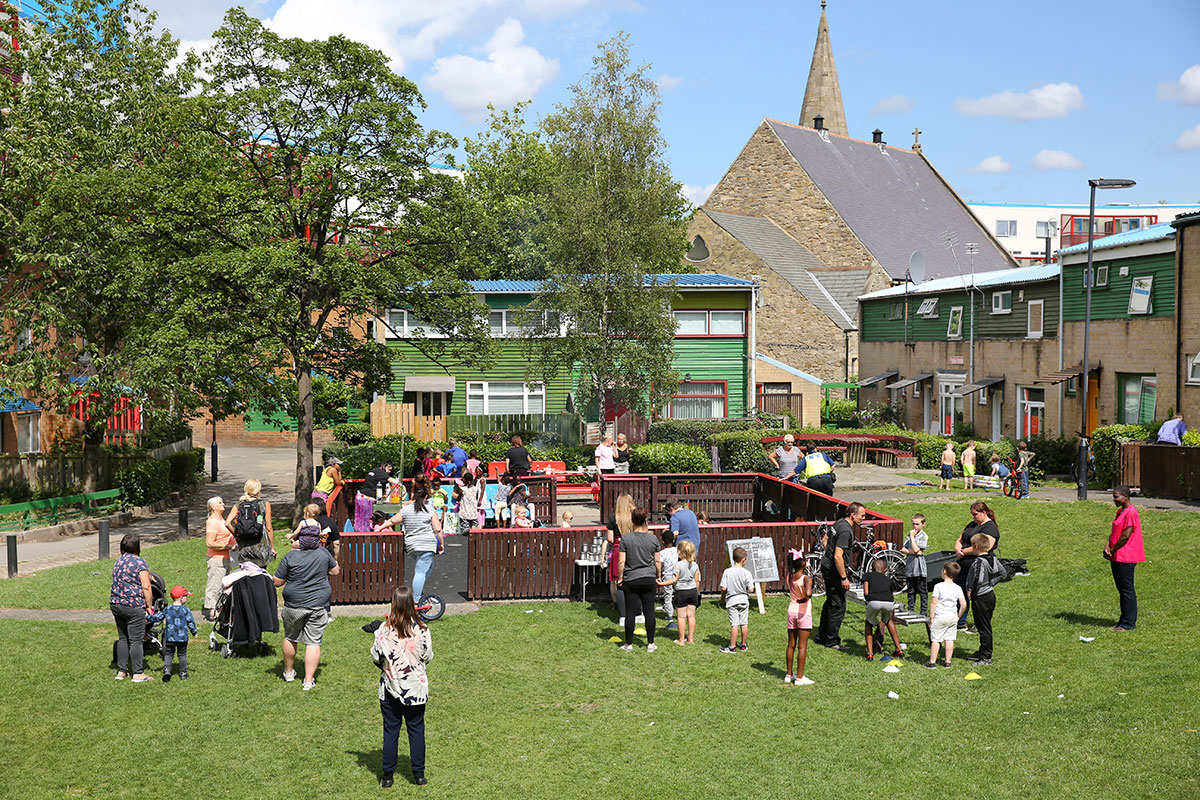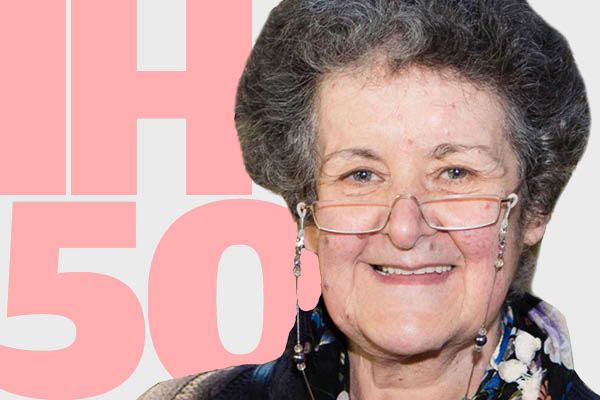A lesson in tenant engagement
Byker Community Trust has formed a partnership with Newcastle University to study tenant engagement. Martin Hilditch finds out what social landlords can learn from the project – following criticism from the government in its green paper. Photography by Alamy and Byker Community Trust
A summer barbecue organised by residents and supported by BCT
Since the Grenfell Tower fire there has been much talk among social landlords about how to better listen to residents’ concerns and involve them more meaningfully in service delivery.
The government has indicated it feels there is room for improvement, following a national conversation it held with tenants after the tragedy.
It had remained tight-lipped about potential solutions, and only published the much-delayed Social Housing Green Paper that sprung out of these discussions this week.
But while the government has been pontificating, one social landlord in the North East of England is already moving ahead with its own plans to improve the way residents can influence the services they receive.
Byker Community Trust (BCT), the 1,800-home housing association which owns and manages the iconic Grade II listed Byker Estate in Newcastle, is looking to turn the art of tenant engagement into a science.
It has embarked on a two-year research programme into the issue with Newcastle University and has secured £129,000 as part of a knowledge transfer partnership.
For the uninitiated, these are three-way partnerships between businesses, universities and graduates (although, for connoisseurs of government jargon, the graduates are referred to officially as associates, or even ‘conduits for change’).
The idea is that businesses get help to innovate and improve the way they operate, universities are able to apply their knowledge and expertise to real-world problems, and the graduates gain experience of managing projects and possibly an ongoing job with the company at the end of the
project.
Jill Haley, chief executive of BCT, thinks the “ground-breaking research” it is looking to carry out, thanks to the partnership, could benefit the housing sector for years to come.
On a scorchingly hot day, Inside Housing visits the Byker Estate, a stone’s throw from the north bank of the River Tyne, to find out just what the trust is hoping to achieve and what theories it is hoping to test.
As it happens, the trust appears to be doing pretty well when it comes to working with tenants and residents. We walk around the estate with the trust’s community engagement officer Emma Leggott, and she is enthusiastically greeted on a number of occasions by children, playing
in various parks and gardens, who obviously know her well.
Eamon Holdsworth, chair of the local residents’ association, whose house looks out on a meticulously maintained bowling green, says Ms Leggott is easy to get hold of, and if there are any problems to be raised “you can always contact someone [at the trust] and you always get a result”.
When we stumble across a man who appears to have collapsed on a path outside a local church, Ms Leggott calls an ambulance while gently guiding a young girl playing nearby away from the area so she doesn’t become distressed. These are all examples of what Ms Haley calls “the Byker approach”.
An aerial view of Byker Estate, Newcastle upon Tyne, featuring the Byker Wall
It is clear from talking to Ms Haley that this ‘approach’ is absolutely fundamental to the way the trust operates. So what exactly is it? For starters, the Byker approach was developed with tenants and puts their empowerment at its heart, Ms Haley states. Every tenant has a named housing officer and is guaranteed an annual customer care visit – so each person’s views on how to improve neighbourhoods, services and performance is listened to. “It’s about humans, it’s about face-to-face contact,” Ms Haley states.
The central aim is for BCT’s customers to “have a confidence that they will be heard and their involvement will make a difference”, she adds. All of which may help explain why Byker Estate won the great neighbourhood award at the Academy of Urbanism Awards 2018. Ms Haley says she thinks that tenant involvement and a “bottom-up approach” to housing management “stabilises estates”. “It gets people to take responsibility for their home, their street, their neighbourhood and their environment,” she adds.
“It is about getting tenants more involved and having a better say about the way services are run.” - Lisa van Heereveld, knowledge transfer partnership officer associate
If everything is looking rosy, though, what is BCT hoping to achieve with the partnership? What can it really be hoping to gain?
Step forward Lisa van Heereveld, the graduate picked to lead the partnership. Ms van Heereveld says that the partnership work is all about looking at how customer engagement could be improved – and the knock-on effect this will have on their lives, and also BCT’s wider performance. “In particular it is about getting tenants more involved and having a better say about the way services are run on the estate and delivered to them,” she states.
“Where the bottom line fits in, is the idea that when tenants are more involved and [we] improve satisfaction and the way they feel about the estate, it will reduce the voids you have, the arrears.”
That means looking at different ways in which tenants and residents can contribute their own ideas and directly shape the service delivered by the association.
(Left to right): Craig Clark (knowledge transfer partnership officer, Newcastle University), Lisa van Heereveld (knowledge transfer partnership officer associate), Eleftherios Alamanos (senior lecturer, Newcastle University), Jill Haley (chief executive, BCT)
Newcastle University will help BCT access the most up-to-date existing research about community engagement and innovative ideas from the services sector.
Ms van Heereveld’s first job is to look at all of the data BCT holds on tenant involvement and satisfaction, and to talk to tenants “to find out how the Byker approach is impacting them and how we can build on it and improve it in a sustainable way”.
Ideally this will result in a “framework we can share with the housing sector to improve things” more widely, she states. At its most basic, the work will help the landlord understand what work it could undertake that tenants would value most – and better learn how they want to engage with it.
Ms van Heereveld also wants to understand, based on the conversations and existing data, if there are any links between the way people feel about the association, or their estate, and their willingness to engage and get involved in decision making.
The working theory is that more people are likely to be active if “they are really positive about the estate” – but equally it could be negative experiences that have prompted people to try and make a difference. “I don’t know right now what the outcomes are going to be, otherwise I wouldn’t have to do the research,” she says with a smile.
Part of the research will also look at what services people want to access digitally – and potentially help develop technological solutions that will help tenants access services.
This article has also bandied the term engagement a lot. But the partnership team wants to better understand what this means to tenants and on what terms they want to engage with their landlord.
Byker Community Trust aims to test the true meaning of tenant engagement through a partnership with Newcastle University
Key questions include how existing approaches can be tweaked, altered or even abandoned in order to make people feel they “can easily change the way we do things”, Ms van Heereveld states. Whatever emerges as a result must be genuinely co-created with tenants, she adds.
For Ms Haley, the work is in part about refining the Byker approach to housing management, but also about providing an evidence base. Ultimately the hope is to prove “this does work and has been proved to improve the bottom line [for social landlords] if you do it”, Ms Haley adds.
Of course, it could be about challenging the organisation’s approach, too. “This is why the partnership with the university is so important,” Ms Haley states. “This [the Byker approach] is our perception on the basis of the people we engage with. Is that the right way? I don’t know. So, I think testing this and having an independent professional body looking at it to see whether that is right or not, is a good thing.”
While this will definitely inform BCT’s approach moving forward, Ms Haley wants the research to have a wider impact. Ultimately she would like to have an approach, backed up by the learning, that could be rolled out by landlords operating in other areas that “are undergoing lots of different deprivation challenges”.
There is much work to be done – the partnership will run for two years. As we leave, Ms van Heereveld is returning to an ongoing “literature review of value co-creation articles” and analysing customer involvement trends.
There is one lesson that social landlords can have for free, though – make sure you genuinely listen to your tenants if you want to create a service that truly delivers for them.
“It isn’t one size fits all, it’s circumstantial,” Ms Haley concludes. “There isn’t a manual that says ‘this is the best way to do it’.”
Knowledge transfer partnerships
Knowledge transfer partnerships have existed for 40 years and their prime purpose is to help businesses in the UK innovate and grow, writes Sophie Richards
There are three main members of the partnerships: the businesses, which are then linked to universities or research organisations, and a graduate.
The partnership brings the business new skills and the latest academic thinking, while creating a planned, specific project that aims to positively impact the business. They can last between one and three years, dependent on what the project is and the needs of the business.
A partnership is partly funded by a grant from Innovate UK and other government co-funders, the rest comes from the business’ own contribution.
The amount funded by the government depends on the size of the business. Generally, a small to medium-sized enterprise would be expected to contribute a third of the cost, while a larger enterprise could be expected to contribute up to half of the cost.
According to Innovate UK there are currently 726 partnerships in the UK.
















